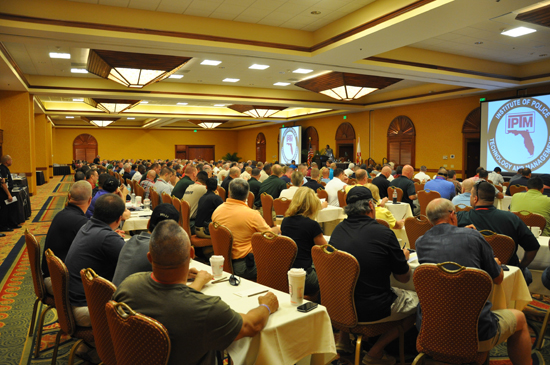- WE SAVE LIVES
- info@wesavelives.org
What Does It Take to Get Drugged Drivers Off the Road?
Congratulations to our partner, Gerald Waters
September 16, 2016Should this drunk driver’s sentence be less because he confessed to a violent crime?
September 16, 2016What Does It Take to Get Drugged Drivers Off the Road?
Guest Blogger
 Kyle Clark is a Training Specialist with the INSTITUTE OF POLICE TECHNOLOGY AND MANAGEMENT, University of North Florida. He is trained in the detection of drug-impaired drivers, beginning in 1995 with the Drug Alcohol Recognition Technician course, continuing with the Drug Recognition Expert school in 1999, and culminating with the Drug Recognition Expert Instructor school in 2000.
Kyle Clark is a Training Specialist with the INSTITUTE OF POLICE TECHNOLOGY AND MANAGEMENT, University of North Florida. He is trained in the detection of drug-impaired drivers, beginning in 1995 with the Drug Alcohol Recognition Technician course, continuing with the Drug Recognition Expert school in 1999, and culminating with the Drug Recognition Expert Instructor school in 2000.
How to Become a Drug Recognition Expert
Each year, nearly 44,000 impaired drivers and approximately 4,300 drugged drivers are arrested in the state of Florida. This is only the tip of the iceberg when you consider more than 100 people are killed and more than 1,500 people are injured in drugged driving crashes in this state. (Editor’s Note: Although these numbers are probably conservative due to lack of testing for drugs in all cases when someone is arrested). One of the problems law enforcement has when arresting a drugged driver is obtaining sufficient evidence to demonstrate the subject is impaired by drugs at the time of the arrest.
Due to the complexities of drugged driving vs drunk driving, law enforcement officers years ago had difficulty in successfully prosecuting drug-impaired driving cases. With alcohol-impaired arrests a blood or breath alcohol level commonly presumes impairment at a particular level, i.e. 0.08 grams of alcohol in 100 milliliters of blood. Drugs are not so easily quantified in this manner. Thirty years ago, Los Angeles traffic enforcement officers were consigned to bringing a potential drug-impaired driver to a hospital and request a diagnosis from the attending emergency room physician as evidence of drug intoxication. This procedure was quickly recognized as unmanageable due to the court appearance obligations placed upon the physicians and another method of collecting evidence of drug impairment became necessary. Two officers from the Los Angeles Police Department researched the observable effects of drugs on impaired subjects and adopted medical practices that provided objective evidence to indicate impairment. The result was the Drug Evaluation and Classification Program (commonly referred to as the Drug Recognition Expert Program), established at the Los Angeles Police Department in 1979.
The National Highway Traffic Safety Administration (NHTSA) investigated the Drug Recognized Expert (DRE) program and recognized the potential this program offered to the detection of impaired motorists. NHTSA helped standardize the program and disseminate it among interested states. Currently there are 49 states in the Drug Evaluation and Classification Program (DECP). There are approximately 7,000 DREs throughout the U.S., and there are also DREs in Canada, China, the United Kingdom, Australia, Germany, and the U.S. Virgin Islands. California has the greatest number of DREs in the country at over 1,000. Florida currently has 236 DREs in many areas, particularly populated areas, yet the need remains for DREs in over half of the counties. Manpower shortages and budget limitations often deny many agencies from participating in the DECP.
The training is both extensive and intensive and takes place one to two times a year. Florida officers interested in applying for the DRE school must have completed the International Association of Chiefs of Police (IACP) Standardized Field Sobriety Testing course, and the Advanced Roadside Impaired Driving Enforcement course. With this training, and with the written recommendation of a local prosecutor, officers can apply for acceptance into the two-week training course. It consists of:
- An awareness of the drug-impaired driving problem locally and nationwide.
- The identification of the seven drug categories that impair a person’s ability to drive a vehicle safely.
- An overview of human physiology.
- The methods used to introduce drugs into the body, the effects drugs have on the body’s systems, the duration of the drug effects, and the overdose signs for the drug.
- Training to take vital signs, including pulse rate, body temperature, and blood pressure using a blood pressure cuff and stethoscope.
- Training to observe the effects drugs have upon the central nervous system, including horizontal gaze nystagmus, pupil size estimation, and reaction to light
- Training in preparing a curriculum vitae – a summary of relevant training and experience, to be used in future legal proceedings.
- Training in proper courtroom preparation and testimony regarding drug-impaired driving offenses.
- Proper administration and interpretation of a drug influence evaluation.
Following the two weeks of DRE School a DRE Candidate enters into the certification phase of training, which is similar to a field training program, or internship. This internship requires the DRE candidate to conduct a minimum of 12 drug influence evaluations under the supervision of a DRE Instructor. During these twelve evaluations, the candidate must observe subjects under the influence of at least three of the seven different drug categories, and their opinions must be corroborated through toxicological analysis. Candidates must have a drug category-prediction confirmation rate of at least 75%. In addition, prior to certification each candidate must pass a comprehensive final knowledge exam, and be recommended for certification by two DRE Instructors. This certification period typically requires 30 or more hours of training.
Because of the difficulty of this training, not every officer will become a DRE. Officers volunteer to apply for the DRE school, and only qualified officers are accepted. Once a DRE has obtained a sufficient level of experience and demonstrates potential as an instructor, DREs may also apply for DRE Instructor school which is offered once every few years. DRE Instructors are permitted to teach in a DRE school, assist with the certification of DREs, and to teach the Advanced Roadside Impaired Driving Enforcement class.
Once a suspect is pulled over and there is concern that he or she is under the influence of drugs, the stopping officer conducts a roadside investigation to determine if the subject is actually impaired. If the officer observes sufficient evidence indicating the driver is impaired, an arrest is made and the driver is offered a breath alcohol test to determine if the impairment can be attributed to alcohol. If there is little or no alcohol in the person’s body, the arresting officer requests the assistance of a DRE. Frequently, DREs are not the arresting officer and enter the investigation after the arrest and breath-alcohol testing.
The DRE obtains background information concerning the roadside investigation and learns of any statements made by the driver or of any drugs or drug paraphernalia that may have been present at the scene. Next, the DRE interviews the driver and looks for evidence that a medical condition may be responsible or have contributed to the impairment. DREs have often identified subjects suffering from a diabetic condition, experiencing a stroke, or recovering from a seizure and provided them access to life-saving medical care. In cases of medical conditions causing impairment, the DRE’s role is finished.
In impaired driving cases not involving a medical condition, however, the DRE completes a twelve-step process to identify possible drugs that are causing the impairment. These steps include:
- obtaining vital sign measurements,
- eye tests to detect impairment in the central nervous system,
- psychophysical testing, pupil behaviors in different lighting conditions,
- and an assessment of the driver’s muscle tone.
Further, the DRE looks for evidence of ingestion by looking for fresh intravenous needle injection sites, examining the inside of the mouth and looking into the driver’s nostrils. The results of these procedures are recorded and interpreted according to medically-consistent criteria regarding drug usage and intoxication.
Following the drug influence evaluation, the DRE drafts a report detailing the observations made during the evaluation and interpreting their meaning. This report is forwarded to the prosecuting attorney in addition to the report generated by the arresting officer. Many times a toxicologist is unable to say with any degree of scientific certainty if a drug found in a biological specimen was indeed responsible for the impairment at roadside. Without this link, the prosecution’s case is in jeopardy. The additional evidence obtained by the DRE provides the prosecutor with the necessary evidence that links the arresting officer’s evidence at roadside with the toxicology results found by the laboratory.
Prosecuting the drug-impaired driver is a team effort. The arresting officer is the critical first step of this process, and the impaired driving detection skills possessed by the arresting officer often make the difference between arresting the drug-impaired driver or releasing the driver back on the street. The DRE and the toxicologist provide supporting roles to bolster the arresting officer’s case when impairing drugs have been used. It is the prosecutor’s responsibility to provide all of this evidence in a neat package for the jury to consider. Each member of this team must stay current in their respective field, as a breakdown at any point can result in a guilty driver being acquitted. https://wesavelives.org/




